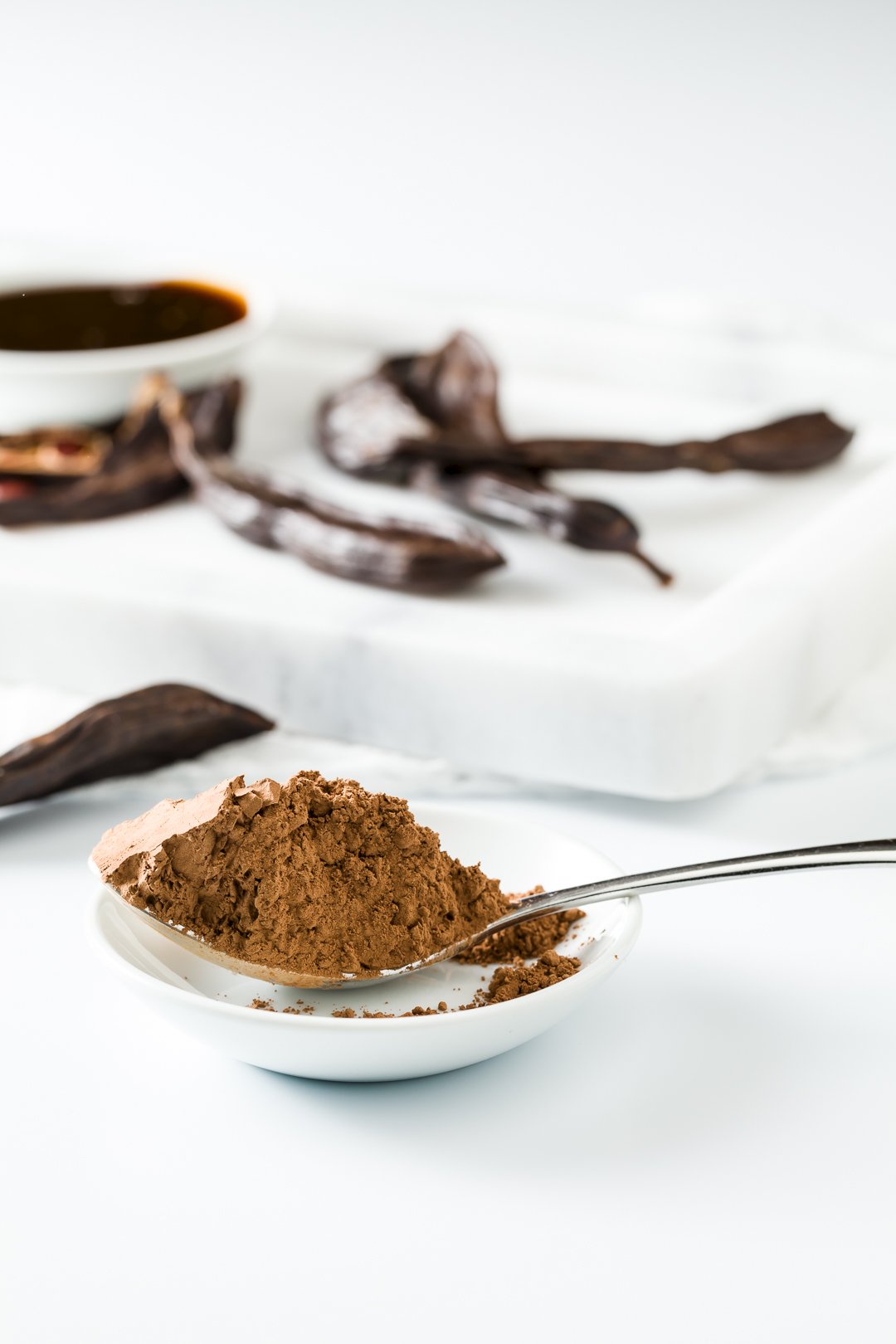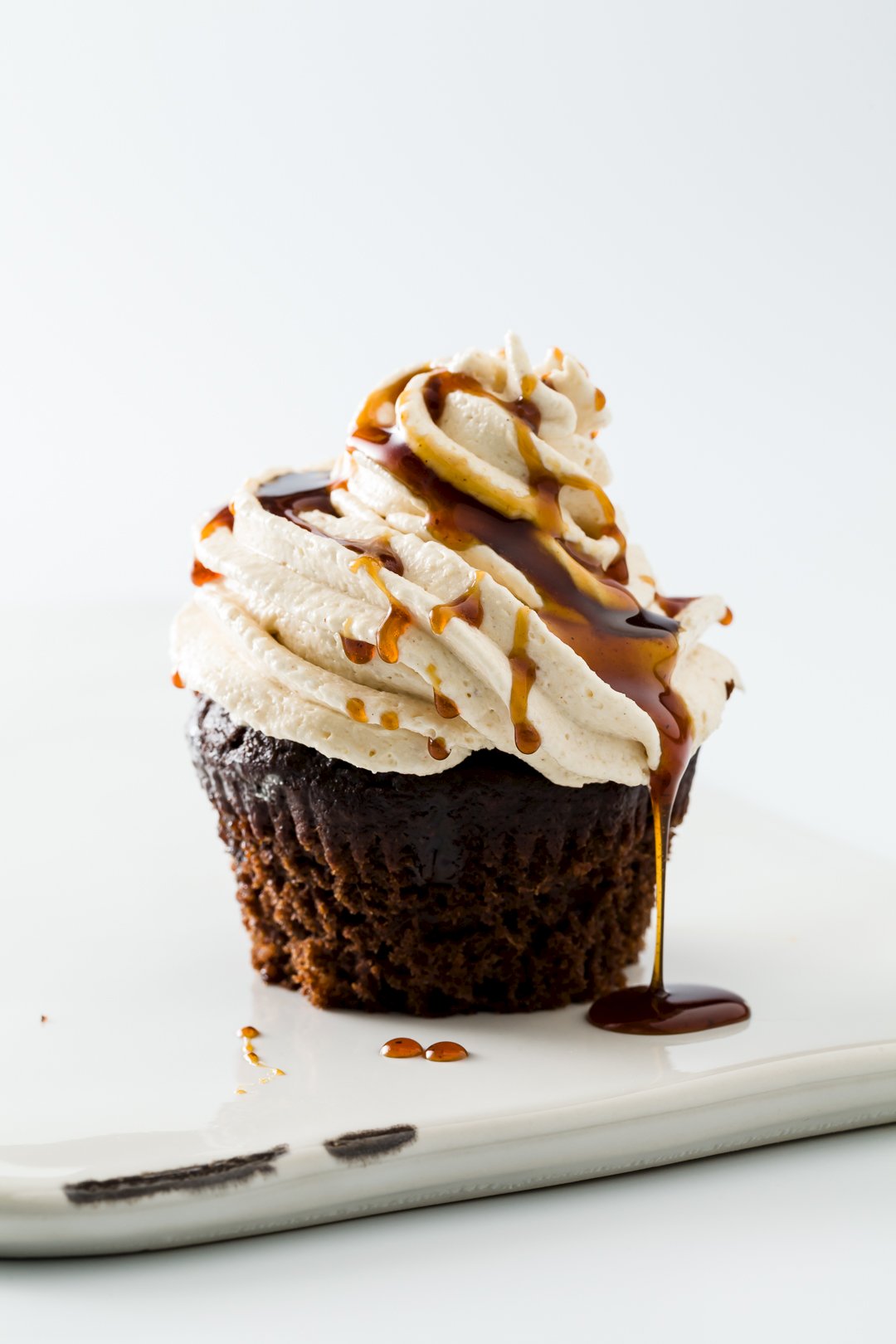All About Carob
What is Carob? Carob might seem just like chocolate when processed into powder or chips and packaged just like our favorite cacao products, but carob and chocolate are completely different in terms of origin, taste, and chemical composition.
At some point, you’ve likely crossed paths with carob and wondered how carob is different from chocolate. Whether you spotted a bag of carob chips nestled among baking add-ins in your local health food store or found a can of carob powder perched alongside the dry ingredients, you probably noticed that it looked a heck of a lot like chocolate.
How do the two really compare? Does carob taste like chocolate? Is it really a healthier option? How is carob different from chocolate, and (perhaps most importantly) how should we use it?

What is Carob?

Carob (from either the Arabic “kharrub” or the Hebrew “harub”) is made from the fruit of Ceratonia siliqua, a flowering evergreen tree native to the Mediterranean. The tree’s fruit is a legume (picture a king-sized snow pea) that takes a full year to mature.
After harvest, the whole pod is dried or roasted before it is used in culinary applications.
How is Carob Different From Chocolate?

Carob has long been used by Mediterranean cultures in sweets, drinks, and even folk remedies. It is marketed to Americans predominantly as a chocolate alternative.
If carob is most often used as a chocolate substitute, you may well wonder how carob is different than chocolate.
- Carob pods and cacao beans grow on completely unrelated trees. While Ceratonia siliqua is native to the Mediterranean, Theobroma cacao grows in South America. The fruits of these trees are also processed differently.
- While the entire carob pod is used, only cacao seeds are used to make chocolate. The carob pod and its seeds are used in different ways – to make carob powder, carob molasses, carob flour, locust bean gum, and even animal feed. In contrast, cacao pods (the fruits of the cacao tree) are sliced open and the seeds (beans) inside are dried and fermented to reduce bitterness, to intensify flavor, and to break down phytic acid. After fermentation, the cacao beans are further processed before being used.

- The chemical composition of the two plants is also vastly different. Cacao, even in its purest form, is calorie dense and high in fat, whereas unadulterated carob has no fat. (This is clearly not the case once carob is made into things like carob chips, replete with added sugar and oils.)
- Carob has significantly more carbohydrates than chocolate and is naturally sweeter. These differences make perfect sense when you consider the parts of each fruit being consumed: seeds are full of natural fats, while seed casings are fibrous and carbohydrate-rich.
- Chocolate contains two stimulants, theobromine and caffeine, whereas carob contains neither. This means that carob won’t give you an instant energy boost, but that it is also free of pesky side effects such as heart palpitations, insomnia, and the jitters. For children, pregnant women, and those sensitive to caffeine, this lack of stimulants is what makes carob an appealing alternative to chocolate. This also means that carob and products made with carob are suitable additions to pet treats (see below)!
What Does Carob Taste Like?
For bakers – and for all beings in possession of taste buds – perhaps the most pressing question is how the two compare in terms of flavor. Is carob a convincing substitute for chocolate? In a word: NO. Sandra Boynton, well-known children’s writer and author of Chocolate: The Consuming Passion, says it best:
Some consider carob to be a reasonable substitute for chocolate because it has some similar nutrients (calcium, phosphorus) and because it can – when combined with vegetable fat and sugar – be made to approximate the color and consistency of chocolate. Of course, the same arguments can also be made in favor of dirt. (27)
Carob shouldn’t take this assessment too personally, as Boynton also compares white chocolate to the paper on which her book is printed.
Carob powder, chips, and molasses may not taste of cacao, but they do have a sweet, rich flavor all their own.
Just know that while you can sneak silken tofu into a chocolate cream pie or ditch refined sugar for fruit to sweeten a cake with no one the wiser, you aren’t going to pass off carob chip cookies for the gooey, chocolatey classic.
How Do You Use Carob?
Carob can be used in a variety of different ways:
- As an alternative to chocolate.
- As a sweetener.
- With chocolate. If you aren’t looking to eliminate chocolate from the equation, carob can also be used, much like espresso powder, alongside cacao to intensify chocolate flavor.
- As a home remedy. Outside of baking, you can try carob as a safe and soothing digestive aid. At least one study has shown carob powder to be an effective treatment for acute diarrhea in children. Some claim that carob is also effective in easing pregnancy-induced nausea. Dr. Andrew Weil recommends that carob powder be mixed with applesauce (another easily digestible food) to make the remedy more palatable.
- In dog treats. If you like to make your own homemade dog treats, or feel compelled to bake your dog a birthday cake, carob is your best bet for “chocolate” flavor without theobromine, which is toxic to canines and many other animals. Added bonus: your dog sure won’t know the difference between carob and chocolate!
You’ll find carob in a variety of formats. Some of the most common ones are as follows.
Carob Powder

We get carob powder [paid link] from the fruit’s outer pod.
Carob powder can be used as a straight substitute for cocoa or cacao powder. But, as you read above, it doesn’t taste quite the same as cocoa powder.
Carob Molasses

The entire fruit is used to make carob molasses, a decoction made by boiling dried carob fruit and reducing the resulting liquid.
In Lebanon, carob molasses was traditionally used as an alternative to sugar. Mixed and served with tahini or sesame paste, for example, it is still eaten as a dessert called dibs bi tahina – an Arabic version of peanut butter and jelly.
Carob Chips
Carob chips can be thrown into recipes in place of chocolate chips, but they won’t behave the same. Melting them successfully is a task achieved only through great difficulty, with careful timing, added oil, and the favor of the baking gods. Carob is simply not as fatty as chocolate and doesn’t respond the same way to heat.
Is Carob Healthier Than Chocolate?
One question that many have about carob is whether it is better for you than chocolate. Unfortunately, there’s no one-size-fits-all answer to this question.
In their purest forms, both cacao and carob are fairly nutritious:
- Both carob and chocolate contain antioxidants and a variety of vitamins and minerals.
- Both carob and chocolate contain B vitamins, though carob contains slightly more.
Some would say that carob is healthier because:
- Carob naturally has no fat. Chocolate’s high fat content makes it a poor choice for those on low-fat diets.
- Carob has a decent amount of fiber and contains tannins. Tannins act as an astringent in the digestive system, helping to clear out toxins. These tannins make carob a good choice for those with malabsorption syndromes such as Celiac Disease.
- Carob is stimulant-free. Since stimulants like caffeine and theobromine can irritate a sensitive digestive tract, carob is also better for those experiencing any kind of acute or chronic GI distress. It may also be a wiser option for those with high blood pressure or for pregnant women seeking to limit their caffeine intake.
- Carob is also significantly higher in calcium than chocolate.
Those that would choose chocolate over carob would point out that:
- Unsweetened chocolate has less sugar than carob. Carob’s high sugar content makes it a no-no for those trying to eat fewer carbs.
- Chocolate contains more iron, magnesium, phosphorous, potassium, zinc, copper, manganese, and selenium.
- Chocolate’s antioxidant content is higher than carob’s.
The bottom line? Both carob and chocolate, in their purest forms, have a place in a healthy diet, though individual health concerns might prompt you to choose one over the other. It should also be noted that the benefits of both foods are often canceled out by the addition of excess sweetener and fat. Chocolate is especially prone to this nutrient nullification, so when buying cocoa products, look for low sugar and high cocoa content.
Recipes Using Carob
In my opinion, the best use for carob is not in recipes where it is asked to stand in for something else, but in those designed to showcase its unique flavor. Carob-based “chocolate” desserts inevitably lead to disappointment. When viewed as a unique ingredient, carob has much to offer.
For recipes that celebrate carob in its own right, try:
History of Carob Usage
Carob’s earliest known use was in ancient Egypt, where – as evidenced by the carob-shaped hieroglyph for “nedjem,” meaning “sweet” – it came to represent all forms of sweetness. Further east, the carob tree became associated with wealth through a tradition of weighing gold and gemstones against its fruit. This practice is the origin of the word “carat,” which comes from the Greek “keration,” or “seed.”
The fruit also took on a spiritual significance in Judeo-Christian tradition, appearing in both the Talmud and the New Testament. Rabbi Haninah, John the Baptist, and the Prodigal Son are all, at some point, sustained by eating carob. From this association with John the Baptist, carob takes the popular names “locust bean” and “St. John’s Bread.”
To this day, carob continues to play a role in the cultural traditions of the wider Mediterranean. Often, it is consumed as a humble stand-in for more luxurious foods during times of fasting and reflection. In Malta, for example, carob syrup is mixed with honey to make sheets of tiny square karamelli tal-harrub, a Lenten caramel eaten in lieu of chocolate and other sweets.
Kharroub, a sweetened carob juice drink, is served during Ramadan in the Middle East, while throughout the Jewish diaspora, dried carob is traditionally eaten straight during the holiday of Tu B’Shevat. (This last practice is not for the faint of heart. In fact, one New York rabbi writes that the carob pod is “hard as a rock and tasteless as wood” with the smell of Limburger cheese!)
Carob didn’t make its way to the United States until the latter half of the twentieth century, when it slipped onto supermarket shelves in all its powder-and-chip glory.
Thanks to Jess Touchette for helping to research and write this carob guide! Jess is a special collections librarian living in St. Louis, Missouri. A food history enthusiast and an amateur baker, she enjoys poring over centuries-old recipes and attempting to bring them new life in a modern kitchen.
Loading comments...